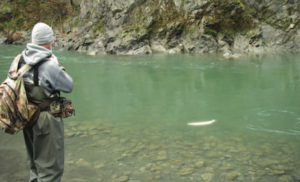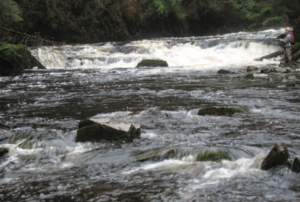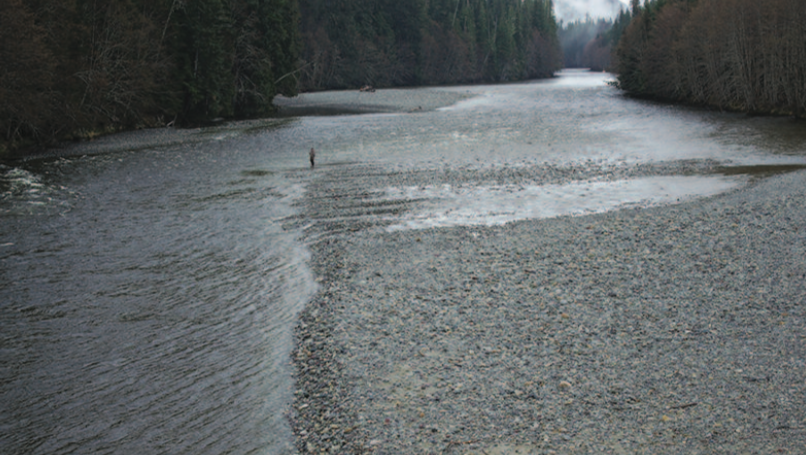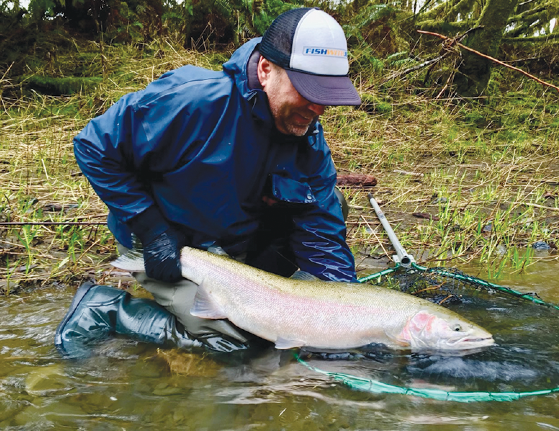BY JD RICHEY
For beginning steelheaders, it sometimes feels as if finding a gold-plated unicorn is easier than catching a chrome-bright, sea-run rainbow. But regardless of your angling style, technique or even the specific river you fish, there’s one sure-fire way to quickly improve your results. And, it has nothing to do with magic bait cures or secret lures. Nope, to really get good at catching steelhead, the real key to success is to fully understand how the fish act — and where they go — based on the temperature, height and color of the water. Get these basic concepts down and you’ll be spending a lot less time between bites.
Water temperature Steelhead are cold-blooded critters and therefore water temperature has a dramatic impact on their actions. When the water gets cold, the fish get really lazy and lethargic. As temperatures rise, they get active again. What’s considered cold on one river may not transfer to the fish on another system, as steelhead get used to the conditions in their particular region.
For example, water temperatures on the American River near Sacramento can be 51-52 degrees, and the fish will get a bit sluggish because they’re used to water temperatures that can range as high as the upper 60s. In the Great Lakes’ tribs, Alaska and many other places steelhead call home, 51 degrees would be considered very warm and the fish would therefore be quite active.
So, you have to take water temps on a case-by-case basis, but the fish generally start feeling pretty chilly somewhere in the low to mid 40s. When they get really cold, steelhead stop acting like trout and become much more “salmon-like.” They’ll seek out the slowest water they can find, often taking refuge in the bottoms of deep, sluggish holes. Hatchery-bred steelhead are more sensitive to really cold temps, while wild ones seem to be able to handle the conditions better.
When steelies are in frigid water, you’ll sometimes have to run really large, flashy offerings to get them to pay any attention. Other times, they’ll only react to the tiniest baits and flies.
One of the best pieces of advice I can give you is to forget about fishing in the early morning when water temps are coldest. Instead, sleep in and go out in the afternoon — that gives the water a chance to warm up a bit (just a degree or two can make all the difference in the world). Not only will most of the crowds be gone, but the fish should bite better too!
In warmer water — generally the mid to high 50s — the fish will be lively and often seek out the meat of a run, typically in the middle of a flat. As temperatures climb higher, steelies will move into the fastest water at the head of a run, which has a higher dissolved oxygen content.
Clarity and flow

The best time to be on a steelhead stream is when it is running an emerald, slightly milky green color — “steelie green,” as it is often called. To understand why “green means go,” let’s examine what happens on a typical river before, during and after a storm.
Low and clear
After a prolonged dry period, the river will usually get low and clear (and cold if it’s wintertime) — conditions that make fishing challenging. The fish get spooky, lethargic and pretty tough to catch when the flows are way down. That’s not to say you can’t get bit when the conditions are like this, but you’ll have to work bit harder to do so. As noted above, water temps can often be very cold in this situation and the fish will gravitate to slower, deeper holes to conserve energy.
Big rains!
Now, let’s say a storm hits and heavy rains cause the river to rise. As it comes up, it will pick up debris and begin to color up. Steelhead don’t usually bite all that well on a rising river as they tend to be in “go-mode,” at that point, but you can still get bit if you are diligent and cover a lot of water.
If it keeps raining, the river will continue to rise and eventually “blow out” (turn muddy). At that point, it’s best to stay off the water until the rain subsides, as catching fish in chocolate-colored water is a tough task. If you absolutely have to go, your best bet it to fish below a clearwater tributary stream.

On the drop
As the river crests and starts to drop, it’s time to get ready — the best fishing is just around the corner! Every river system clears and falls into shape at a different rate, but the basic rule of thumb is the upper end of a river will turn fishable first, so in high water you’ll want to fish high up in the drainage and then work your way downstream as the water recedes.
When the river is still high and what we call “pushy,” the steelhead will hug the banks, avoiding the fast water out in the main channel. Often, they’ll literally be right at your feet, and casts of more than about 10 feet will pass right over the fish.
Once a river drops out of the trees and into its original riverbed — and turns from brown to green — the fish will move to more traditional holding areas (like flats and tailouts) out away from the banks.
“Steelie Green”
When you’ve got a dropping river that’s green and has from 1 to 4 feet of visibility in it, that’s the time fishing usually peaks. The fish have settled into traditional spots like flats and tailouts, and because the color in the water gives the fish a sense of security, they tend to be much more bitey.
Dropping out
Unless you get some rain, however, the river will continue to drop and eventually get back to the low and clear situation. In extremely low water, steelhead will move into fast current zones at the heads of runs and fishing is typically best when the sun is off the water. The exception to that rule, of course, is when the temperatures are extremely cold, which forces the fish into the slower, deeper stuff mentioned above.
When low water conditions persist, the largest concentrations of fish usually are found in the lower reaches of in a river system. Steelhead hanging down low like that in a system can be tough to catch, as they are typically moving around a lot in water that’s generally wider and less defined than upriver.
Drought conditions
You may also encounter low and clear conditions during the summer and fall. In that case, water temps will be on the other extreme — sometimes pushing 70 degrees or more. Confronted with ascending a hot river, steelhead will seek out what are called thermal refuges: spots where cold water flows into the mainstem. Tributary streams are the main holding zones, but some rivers also feature cool springs.
In either case, find the cold water and you’ll likely find the fish. Now, a word about ethics here. In drought situations, steelhead (and salmon) kegged up in small areas near creek mouths can be vulnerable to angling pressure, so do the future fish and fishermen a favor and don’t beat up on them too much. Even if you are releasing fish, know that high water temps really stress the fish out, and survival rates after release can go significantly down.
When it’s hot out, avoid fishing late in the day. Water temps are at their highest in the late afternoon/early evening and that makes fish even tougher to release alive.
The cycle begins anew
Of course, when the next rains hit, the same cycle we just talked about will start all over again. In review:
When the river is on the rise, fishing is usually a little funky just because the steelies are on the move and not necessarily in any predictable locations. Tailouts are always worth a look at this point. If the rains continue and the water gets muddy, either seek out the mouths of clear tributary streams or give it a break until the rain stops.
As the flows crest and then start dropping, the water may still be pretty big, swift and murky. At that time, the fish will travel very tight to the banks to escape the main flow. Assuming the rain hasn’t come back, the water level will continue to drop and clear up. You want to be on the water when the river is emerald green and sporting 1 to 3 feet of visibility… this is when steelhead bite best.
The lower and more clear the river gets, and the tougher the fishing usually becomes — until it gets another bump in flows from rain.
Learn more
To get a full Ph.D level course in all things steelhead, check out my online class, Catch More Steelhead, which features over six hours of on-the-water personal instruction, plus tons of how-to graphics and rigging diagrams. Basically, it covers everything I wish I had known when I was first starting out, and hopefully it will save you countless hours of trial and error and sharpen the learning curve. The course is available at www.catchmoresteelhead.com JD Richey is the owner/operator of JD Richey Sport Fishing in Northern California.
JD Richey is the owner/operator of JD Richey Sport Fishing in Northern California.

the choppy, fast water at the head of a run.




